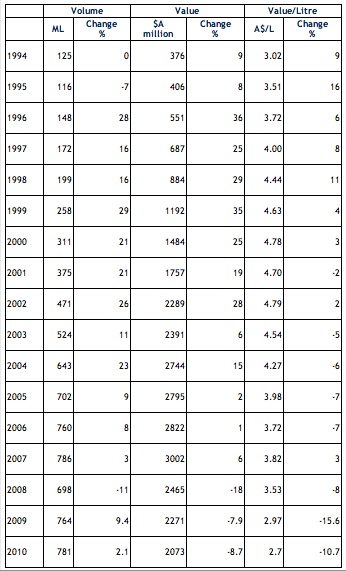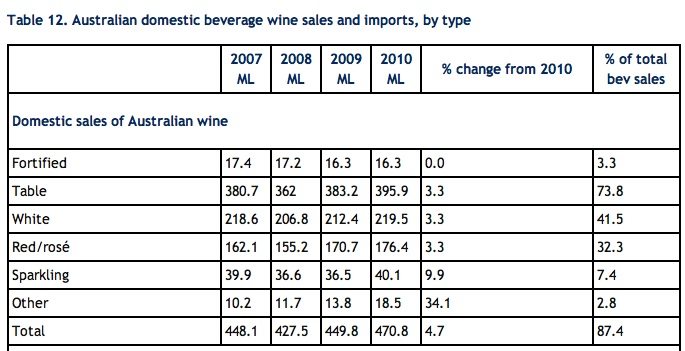 I just received an interesting email from the Wine Australia representative I met at the Wine Bloggers Conference last month. Antonia Muir is memorable because, among other things, she gave me a very cool grey promotional t-shirt with only one line across the chest proclaiming “Everyone Has A Story.” While I am happy to fly that flag of individuality, I also made a mental note that it was the perfect campaign slogan for a sagging Australian wine export business. Antonia’s email advanced the marketing initiative announcing a third year of a nine US city wine immersion program and makes me think the Aussies just might be savvy enough to rekindle US export growth.
I just received an interesting email from the Wine Australia representative I met at the Wine Bloggers Conference last month. Antonia Muir is memorable because, among other things, she gave me a very cool grey promotional t-shirt with only one line across the chest proclaiming “Everyone Has A Story.” While I am happy to fly that flag of individuality, I also made a mental note that it was the perfect campaign slogan for a sagging Australian wine export business. Antonia’s email advanced the marketing initiative announcing a third year of a nine US city wine immersion program and makes me think the Aussies just might be savvy enough to rekindle US export growth.
My encouraging viewpoint is product of an intense debate that regularly rears its head in our Boston tasting group; “How much wine knowledge is required to enjoy the beverage?” The debate always eases with default agreement that wine can be intensely appreciated on multiple levels, depending on how much you want out of it, and that all levels require different amounts of knowledge. Several members of our group study wine through formal educational training and carry a lot chemistry and technical production knowledge. They can link a wine aroma or flavor to a process in the winemaking.
Similar to not really caring to understand what happens under the hood of my car when I turn the key, I don’t really need to know about the wine’s chemistry as long as I enjoy the ride. While it’s fun to pick up bits of insight from my fellow tasters, my interest is focused on palate learning and a developed connection with the winemaker and region of origin.
I like to create stories. I secretly run little wine movies in my head about the winery’s closest village, sunshine and rainfalls, soil underfoot, vistas, paths made by its winemaker walking through the same vineyard rows for months, workers picking clusters, sorting, crush, fermentation, cellar aging vessels, and finally bottling. The mysteries and stories about the transformation of grapes into a beverage with flavors and aromas that can hint at anything but grapes has held my imagination for more than 25 years now. For me, it’s the stories about humans, place, and consumption.
That’s why I was so taken by Wine Australia’s recent campaign. They need it. Australian wine exports have been slumping and I fully believe it’s because we don’t have enough information or stories to build those movies in our heads. Think about the specifc information we have about Piedmont, Bordeaux, Burgundy, and the Loire Valley’s appellations, vineyards, and growers. Do you know the difference between New South Wales and Tasmania? Probably not, and as a result value per litre and total export dollar value has been declining for three straight years following a period of double digit volume growth in the nineties and early 2000’s. Here is the supporting data from Winebiz, Australia’s wine industry portal site:
The locals in Australia, closer to the stories and research we need so badly in the US, have not slowed their consumption of Australian wine and have driven consumption while the rest of the wine drinking world turned their heads:
These opposing trends seem to have created what is possibly the most useful and interesting national wine campaign I have seen since I started following this kind of stuff.
The program consists of six two-hour sessions, hosted by Wine Australia’s Market Development Managers: Mark Davidson, Suzanne Barros and Martin Korson. Each session is designed to compare the regional expressions of the major grape varieties and to explore the less well- known corners of Australia’s viticultural landscape. Throughout the series, participants are supplied with up-to-date, detailed and relevant information on the varietal topic, followed by tastings of benchmark, artisanal and older vintage wines.
This highly successful program concludes with an “all-expenses paid” two-week trip to Australia for the top two participants from each city. The success of this program is evidenced in previous participants’ wine lists and completely altered perceptions of what they thought Australian wine to be.
Program figures, results and numbers, over the past 2 years, include:
Approximately 300 members of the trade have participated 14 markets covered around US (some repeats in 1st and 2nd year due to demand) 200+ Australian wines tasted and discussed in each market Over 2,000 bottles poured Hundreds of wine list placements, a recent survey of just 22 participants from 2010/11 yielded 200 Australian wine additions as a direct result of the program Hundreds of hours of talking!
There are plenty of good Australian wines, but the market statistics prove that a lot of wine professionals and consumers on other sides of oceans don’t have enough information to fuel ongoing learning or interest. This immersion program is taking exactly the right step towards planting the geeky specifics that earn interest. And the Australian wine folks are smart enough to know the answers are not going to present themselves through the usual random trade tastings, sampling, or other tired wine propaganda tactics. It’s time to connect the rest of the world with the geography, vineyard histories, and people that make Australian wine unique and interesting. The email continues:
This program is the cornerstone of Wine Australia’s programs in the US and signals a proactive and important move to re-energize and re-engage with the important gatekeepers within the US market. Australia has much to be proud of with its 200+ years of winemaking, historic old vines, diversity, quality and innovation. We invite you to re-visit Australia, come along to a session and join the A+ Australian Wine conversation.
Sounds like the Australian wine marketing folks have gotten pretty smart…and not a moment too soon.

